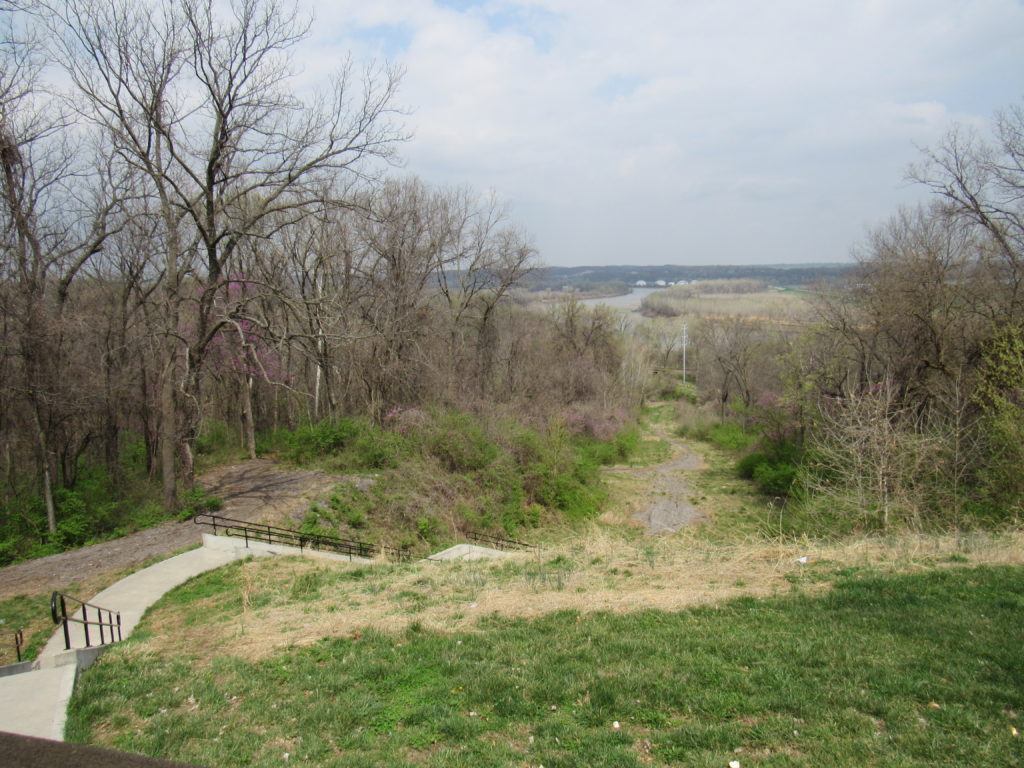
by Mary Rupert
An array of options may open for the future of the Quindaro Ruins in northeast Kansas City, Kansas, after the passage of a bill Tuesday in the U.S. House of Representatives.
The bill names the Quindaro Ruins as a national commemorative site, and that could potentially open funding for programs through the federal government. The bill passed the Senate earlier and now goes to the president’s desk for a signature.
Ideas have been considered of tourists visiting the site on the Underground Railroad, attending educational and informational programs, and going on walking trails around the pre-Civil War era town that borders on the Missouri River.
Yet before any of that should take place, there is a need for more archaeological work at the site, said Marvin S. Robinson II, who has been advocating for preservation of the Quindaro Ruins for many years.
Robinson has hoped for a national historic landmark designation for the Quindaro Ruins, and this national commemorative site designation is considered to be a step toward that. Robinson said the landmark designation currently is under review now by the Interior Department, and a consultant is helping with the preliminary work necessary for that designation.
The designation project has picked up support from Freedom’s Frontier, the Unified Government and other groups in recent years.
The preservation efforts so far have had widespread support from the senators and representatives from Kansas. All voted for the national commemorative site designation bill.
Robinson said he hopes that as the project moves forward, the Quindaro community will be included at the table in the decision-making.
He said he also hopes Dr. Robert Hoard of the Kansas State Historical Society, an archaeologist, is part of the decision-making process and the plan of action at the site.
More archaeological work has not yet been approved, but Robinson said it is necessary. He discussed a LiDAR image process, where images are depicted of buildings and items that might be 20 to 30 feet beneath the surface. That would help identify where all the archaeological sites in the Quindaro Ruins are, he said. Then preservation and restoration techniques could be employed.
Not a great deal of archaeological work has been done at the Quindaro Ruins since it was proposed for a landfill in the mid-1980s, according to Robinson. Most of that work stopped when the landfill project was halted.
There has been some research in recent years, however, confirming that the Union Army rode at the Quindaro town site, including the 1st Kansas Army regiment, Robinson said. Several universities and colleges have participated in research efforts involving the Quindaro Ruins.
“We need to find out where all the archaeology sites were,” Robinson said. “We just have a smidgen of what was there.”
Robinson focused on a portion of the Quindaro area for the site project.
Quindaro was founded in 1856 by the Wyandot Nation, and was named after Quindaro Nancy Brown Guthrie, the spouse of the town’s founder, Abelard Guthrie. It was an abolitionist port town and grew to an estimated size of about 2,000 people. Many of the town’s residents left during or just prior to the Civil War. After the Civil War, exodusters settled near Quindaro, and the former Western University was built in the Quindaro area.
The bill that passed this week recognizes the historic significance of the Quindaro Ruins area, a haven for escaping slaves on the Underground Railroad in the pre-Civil War era. The town, a free-state port on the Missouri River at what is now 27th Street in Kansas City, Kansas, was populated largely by abolitionists and it went into decline around the Civil War. The ruins were abandoned until the 1980s, when archaeologists unearthed significant finds.
While the Quindaro site would not be considered a unit of the National Park system under this bill, the bill would allow local, state and federal governments to enter into agreements with entities to protect historic resources at the site and to provide educational and interpretive facilities and programs at the site for the public. It would allow technical and financial assistance to any entity which has an agreement with the Secretary of the Interior and the local and state governments.
An earlier story from Feb. 27, 2017, about the Quindaro Ruins historic project receiving UG’s approval, is online at https://wyandotteonline.com/quindaro-national-landmark-project-receives-ugs-approval/
The bill that passed Tuesday is online, Sec. 9008, p. 694 of SB 47, at https://docs.house.gov/billsthisweek/20190225/BILLS-116s47-SUS.pdf
A news release from Rep. Sharice Davids: https://davids.house.gov/media/press-releases/rep-sharice-davids-legislation-designate-quindaro-townsite-kansas-city-kansas
A news release from Sen. Pat Roberts: https://www.roberts.senate.gov/public/index.cfm/pressreleases?ID=0AAF02CE-9906-4E10-B710-C93CAC97060C
To reach Mary Rupert, editor of the Wyandotte Daily, email maryr@g3f.1db.myftpupload.com.
